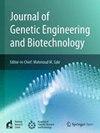scp3 gene expression during ovarian differentiation in Hypoatherina tsurugae (Pisces; Atheriniformes)
IF 2.8
Q3 Biochemistry, Genetics and Molecular Biology
Journal of Genetic Engineering and Biotechnology
Pub Date : 2025-06-11
DOI:10.1016/j.jgeb.2025.100518
引用次数: 0
Abstract
The scp3 gene encodes the SYP3 protein, which forms the synaptonemal complex required for pairing homologous chromosomes throughout the prophase of the first meiosis. In addition, it plays a significant role in the formation of germ cells. The 978 bp scp3 mRNA transcript from Hypoatherina tsurugae was cloned and sequenced. The gene comprises an open reading frame (ORF) of 720 bp encoding 240 amino acids (AA), which are identical to those of various other fish species. A phylogenetic tree was created by comparing the mRNA sequences of 50 fish species from the taxa accessible in the NCBI database, utilizing Acipenser ruthenus as an out-group. The tree revealed a higher homology of scp3 from H. tsurugae with Maelanotaenia boesemani, the 2 forming a single clade. Using qRT-PCR, scp3 mRNA transcript expression was investigated and found to be highly expressed in amhy- (females) during the early gonadal differentiation phase, from day 0 to week 10 after hatching. In contrast, amhy+ (males) showed comparatively low expression. The differentiation of male and female gonads was determined six weeks after hatching, based on histological analysis of gonads recovered from biweekly collected larvae throughout the sex determination/differentiation stage. In this phase, primary oocytes are predictable. The data obtained in this study provide crucial information for further understanding the molecular mechanisms involved in sex differentiation and determination in fish.
卵巢分化过程中scp3基因的表达(双鱼座;银汉鱼目)
scp3基因编码SYP3蛋白,该蛋白在第一次减数分裂的前期形成配对同源染色体所需的突触复合体。此外,它在生殖细胞的形成中起着重要作用。克隆并测序了垂体下动脉粥样硬化978 bp的scp3 mRNA转录本。该基因包含一个720 bp的开放阅读框(ORF),编码240个氨基酸(AA),与其他各种鱼类相同。通过比较NCBI数据库中50种鱼类的mRNA序列,建立了一棵系统发育树。该树显示,来自tsurugae的scp3与Maelanotaenia boesemani具有较高的同源性,两者形成了一个单一的分支。利用qRT-PCR技术对scp3 mRNA转录物的表达进行了研究,结果发现,在雄性海鸡的早期性腺分化阶段(孵化后第0天至第10周),scp3 mRNA在雌性海鸡体内高表达。而amhy+(雄性)表达量相对较低。根据每两周收集一次的幼虫在性别决定/分化阶段所收集的性腺的组织学分析,在孵化后6周确定雄性和雌性性腺的分化。在这个阶段,原代卵母细胞是可预测的。本研究获得的数据为进一步了解鱼类性别分化和决定的分子机制提供了重要信息。
本文章由计算机程序翻译,如有差异,请以英文原文为准。
求助全文
约1分钟内获得全文
求助全文
来源期刊

Journal of Genetic Engineering and Biotechnology
Biochemistry, Genetics and Molecular Biology-Biotechnology
CiteScore
5.70
自引率
5.70%
发文量
159
审稿时长
16 weeks
期刊介绍:
Journal of genetic engineering and biotechnology is devoted to rapid publication of full-length research papers that leads to significant contribution in advancing knowledge in genetic engineering and biotechnology and provide novel perspectives in this research area. JGEB includes all major themes related to genetic engineering and recombinant DNA. The area of interest of JGEB includes but not restricted to: •Plant genetics •Animal genetics •Bacterial enzymes •Agricultural Biotechnology, •Biochemistry, •Biophysics, •Bioinformatics, •Environmental Biotechnology, •Industrial Biotechnology, •Microbial biotechnology, •Medical Biotechnology, •Bioenergy, Biosafety, •Biosecurity, •Bioethics, •GMOS, •Genomic, •Proteomic JGEB accepts
 求助内容:
求助内容: 应助结果提醒方式:
应助结果提醒方式:


